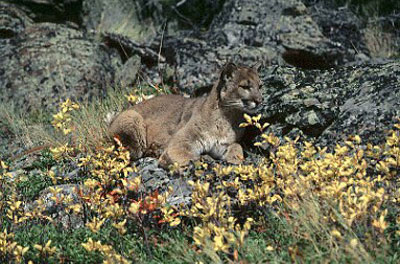
Mountain Lion
(Puma, Cougar)
[Felis concolor]
Geographic Range:
The mountain lion had one of the most extensive distribution of all American terrestrial mammals. It ranged from coast to coast in North America, and from southern Argentina to northern British Columbia. Hunting pressure and other environmental changes have restricted their range to relatively mountainous, unpopulated areas.
Physical Characteristics:
Mass: 67 to 103 kg. The mountain lion is large and slender. The pelage of the mountain lion has a short and coarse texture. The general coloration ranges from a yellowish brown to grayish brown on the upper parts and a paler, almost buffy, color on the belly. The throat and chest are whitish. The mountain lion has a pinkish nose with a black boarder that extends to the lips. The muzzle stripes, the area behind ears, and the tip of tail are black. The eyes of mature animals are grayish brown to golden. The tail is long, cylindrical, and about one-third of the animal's total length. The limbs are short and muscular. The feet are broad, with four digits on hind feet and five on forefeet. The pollex is small and set above the other digits. The retractile claws are sharp and curved. The skull of the mountain lion is noticeably broad and short. The forehead region is high and arched. The rostrum and the nasal bones are broad. The dental formula is 3/3 1/1 3/2 1/1. The mandible is short, deep, and powerfully constructed. The carnassial teeth are massive and long. The canines are heavy and compressed. The incisors are small and straight. The mountain lion has one more small premolar on each side of the upper jaw than have the bobcat and the lynx.
Food Habits:
The mountain lion is essentially a carnivore. It mostly eats moose, wapiti, white-tailed deer, and caribou. It will also eat smaller creatures like voles, squirrels, mice, muskrat, porcupine, beaver, raccoon, striped skunk, coyote, birds, and even snails and fish. They have also developed a taste for poultry, calves, sheep, colts, and pigs. Mountain lions have a distinctive manner of hunting larger prey. The lion maneuvers to within 15m of the prey, then leaps on its back and breaks the animal's neck with a powerful bite below the base of the skull. Yearly food consumption is between 860 to 1,300 kg of large prey animals.
Reproduction:
Mountain lions are polygamous. Courtship and mating occur from December to March. Gestation periods last from 82 to 96 days. A female mountain lion can come into estrus any time of the year. Estrus lasts about nine days. Females usually give birth every other year. After six cycles without mating, the female has a lull for two months before coming into estrous again. A mountain lion in the wild will not mate until it has established a home territory. When the female is in estrous, she vocalizes freely and frequently rubs against nearby objects. The male responds with similar yowls and sniffs the female's genital area. The highest frequency of copulation was nine times in one hour. A single copulatory act lasts less than one minute. There is a 67% chance of conception per mated estrous. Males remain reproductively active to at least an age of 20 years, and females to at least an age of 12 years. Litters vary in size from 1 to 6 cubs with an average of 3 or 4. Birth weight is between 226 to 453 grams. The cubs open their eyes 10 days after birth. At the same time their ear pinnae unfolds, their first teeth erupt, and they begin play. The cubs are fully weaned at about 40 days of age. Mother and cubs remain together for as long as 12 months. Males reach sexual maturity at about 3 years of age and females at 2 1/2 years.
Behavior:
Mountain lions are solitary animals. Their solitary existence is interrupted during the breeding season and during the period of juvenile dependence. Population densities vary from as low as one individual per 85 square kilometers to as high as one per 13 to 54 square kilometers. These mammals space themselves so that local food supplies and other essentials are not depleted. Females with dependent cubs live within the wide space used by the resident male. Residents mark their territories by depositing urine or fecal materials by the trees they marked with scrapes. The mountain lion is primarily nocturnal in its activity. It acquaints itself with its environment and food sources by relying mainly on vision, smell, and hearing. The mountain lion vocalizes with low-pitched hisses, growls, and purrs to get attention. The loud, chirping whistle by the young serves to direct the mother's attention to the cub. Males are found together immediately after leaving their mother, but rarely as established adults. The mountain lion has summer and winter home areas in different locations, requiring a migration between ranges.
Habitat:
Mountain lions utilize a wide range of habitats including montane coniferous forests, lowland tropical forests, grassland, dry brush country, swamps, and any areas with adequate cover and prey. Dense vegetation, caves, and rocky crevices serve as temporary shelter places.
Biomes: tundra, taiga, temperate forest & rainforest, temperate grassland, chaparral, desert, tropical rainforest, tropical deciduous forest, tropical scrub forest, tropical savanna & grasslands, mountains
Economic Importance for Humans
Positive
Mountain lions have considerable trophy value. Their pelt is either fashioned into a rug or attached to a wall as a flat skin. Mountain lions are hunted for sport. They are also captured to be put in zoos.
Negative
Mountain lions are considered to be threats to domestic stock and also considered a potential danger to children and adults. However, the ferocity of the mountain lion is often exaggerated.
Conservation Status: threatened

